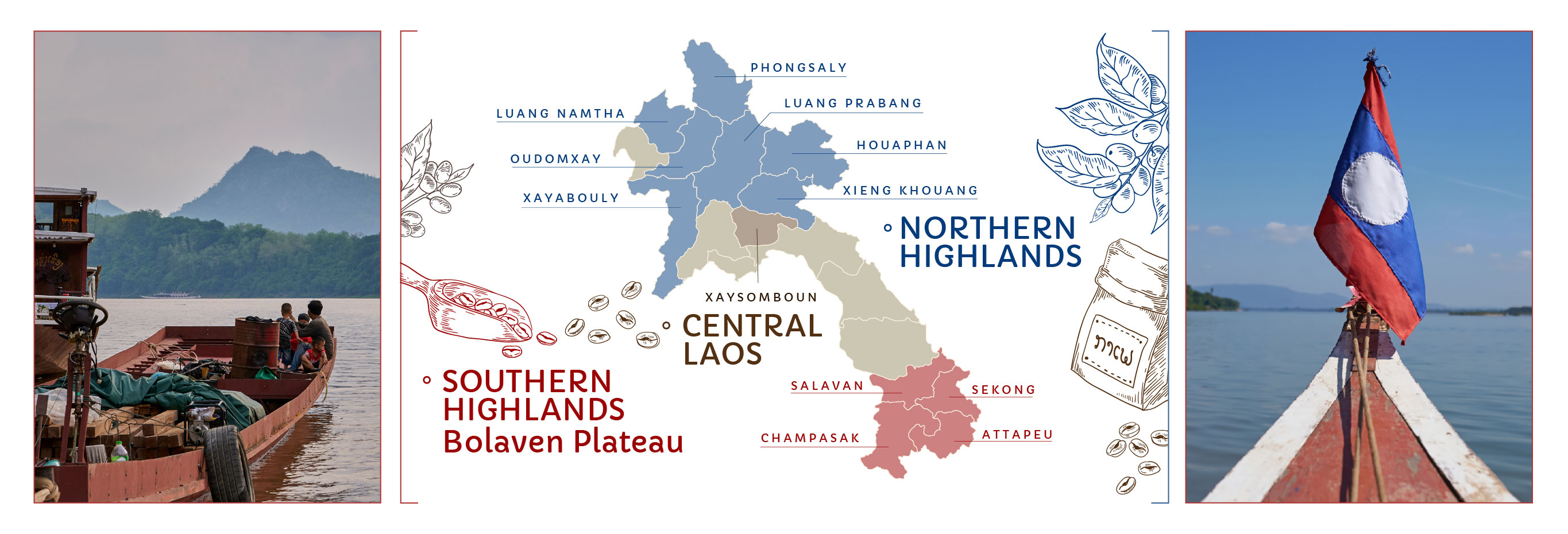Bolaven Plateau
The Magic
of the Bolaven Plateau
The Bolaven Plateau in southern Laos is a region of incredible natural beauty and deep historical significance.
Millions of years ago, a massive meteorite struck the area, followed by volcanic activity that enriched the soils, creating a fertile haven for agriculture. Today, this unique geological past is the foundation for some of the finest coffee in the world.
Nature, history and culture converge on the Bolaven Plateau. Scattered across the plateau are ancient ruins and temples, many yet to be fully explored.
At the base of the plateau lies the ancient Champasak Kingdom, a centre of the Khmer Empire, tied to the grandeur of Angkor Wat. The 1,000-year-old Vat Phou temple complex, a UNESCO World Heritage Site, is a little-known testament to this extraordinary civilization.
The mighty Mekong River weaves through the landscape, parting mountains and valleys and giving life to everything it touches.
Each day, morning mist drifts through the mountains, blending with the soft chants of monks in the many temples that dot the region. This serenity belies a dynamic environment that nurtures exceptional Arabica and Robusta beans. The Bolaven is truly an unforgettable coffee country.
The Bolaven Plateau is one of a handful of places in the world suitable for both high-altitude Robusta and Arabica.
Other regions include Vietnam, and parts of Indonesia and Uganda.
The plateau’s elevation ranges from 800–1,350 m, its cool climate creating ideal conditions for both high-altitude Robusta and premium Arabica coffee. While Robusta typically grows at lower altitudes, it thrives here at 800 m, and Arabica flourishes at higher elevations.
The rich volcanic soil enhances fertility, making it perfect for producing high-quality coffee.
Tea is also grown in the Bolaven, however, the combination of geography, historical introduction, economic benefits, and government support has made coffee a more prominent crop. Laos’ unique ability to produce high-quality coffee beans, especially at high altitudes, has solidified its position as a coffee-producing nation rather than a tea producer.
Cornerstone of the Lao Coffee Industry
The southern provinces of Champasak, Sekong, Salavan, and Attapeu account for 95.9% of Laos’ coffee production. These regions are the core of the coffee industry due to their favourable growing conditions.
Coffee in the Bolaven is largely grown on smallholder, family-run farms of 0.5–1.5 hectares (ha). Traditional and sustainable methods are used to produce high-quality coffee.
Larger commercial plantations, like the Thai-owned Paksong Highlands, use modern techniques to increase production and connect Laos to international markets.
In 2001, TCC Group Thailand began investing in coffee cultivation on the Bolaven Plateau through Paksong Highland Co. The operation spans 700 ha, with coffee plants aged 7–15 years, and ongoing replanting ensures steady production. They grow over 22 varieties with a focus on sustainable and innovative practices. Paksong Highland Co. coffee is distributed locally and internationally.
Covoya is a subsidiary of the international coffee giant, Olam. They grow coffee on 1,300 ha in the rich volcanic soils of the Bolaven Plateau, with plans to expand to 2,000 ha.
Despite competition from larger companies, a shift toward sustainable practices and equitable business models offers smallholder Lao coffee producers more opportunities to thrive. Certifications like Good Agricultural Practices (GAP) help gain access to premium markets, though cost and compliance challenges persist.
Small farms are gaining support through various initiatives and trends. Farmer-owned coffee companies empower producers to keep more profit and control, reducing dependence on intermediaries.
Specialty coffee processors, millers, and roasters, such as Yuni Coffee, Yrou Coffee, Comma Coffee, Bolaven Farms, Bolaven Plateau Coffee Producers Cooperative (CPC), and Jhai Coffee, are forming direct relationships with small farmers, offering better prices and ongoing support.









